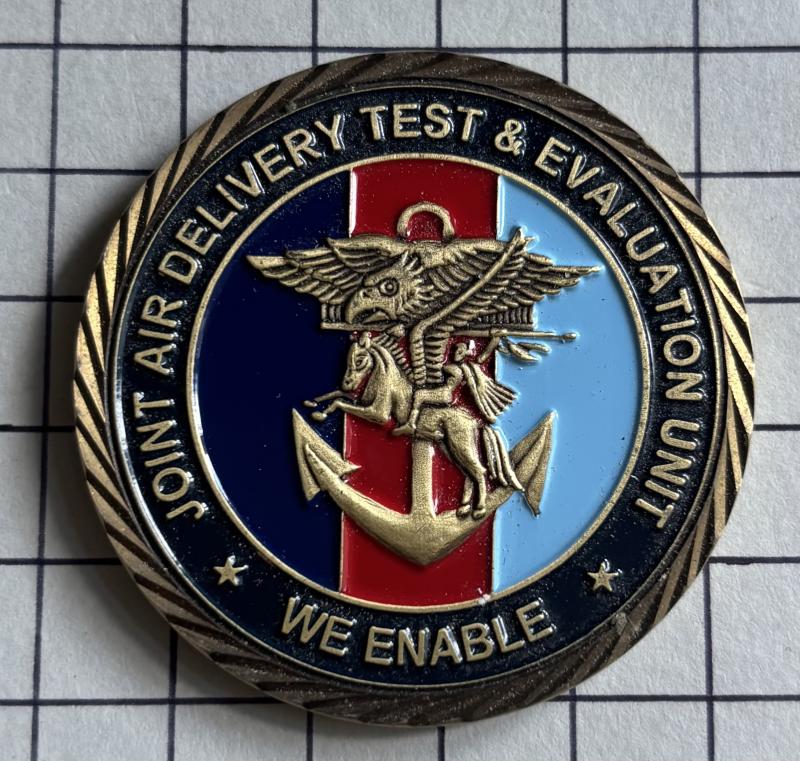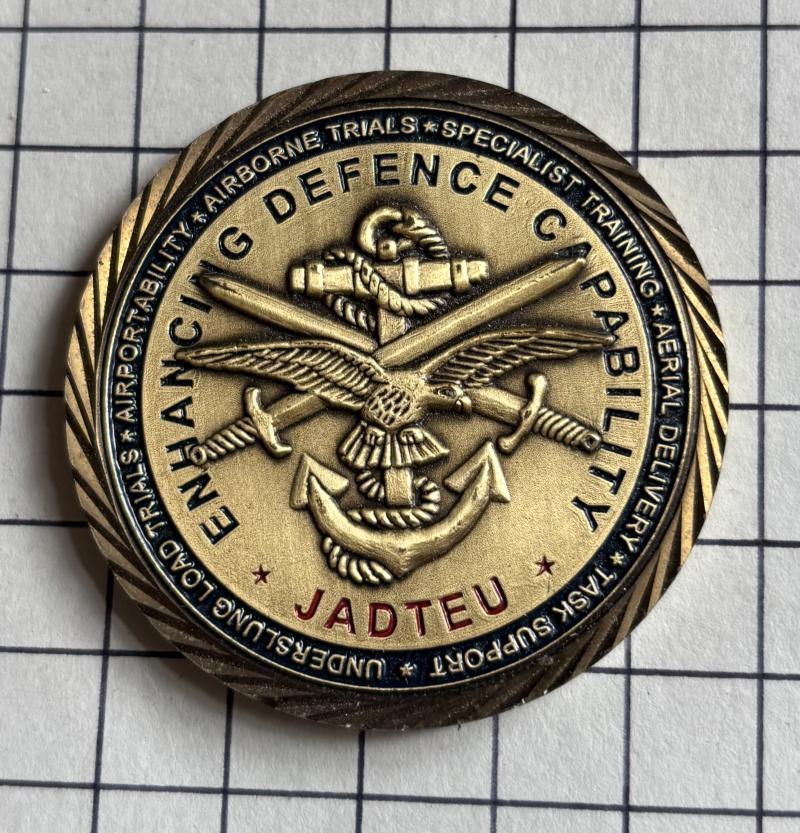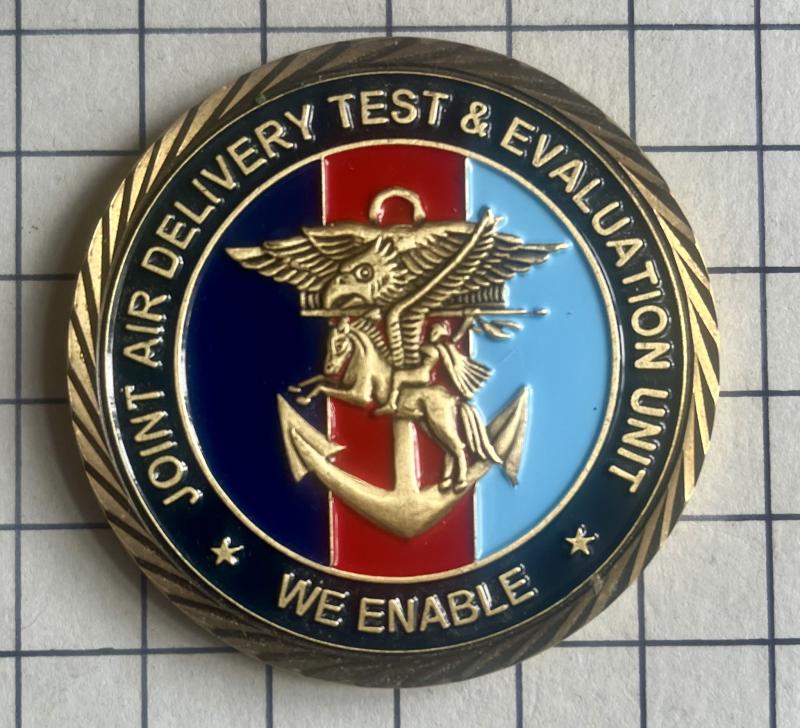c2013 Joint Air Delivery Trials & Evaluation Unit (JADTEU) Challenge Coin
Scarce, pre-2014 J.A.D.T.E.U. Challenge coin given to members on arrival to the Unit. VGC.
Combined Operations badge to front.
JADTEU is manned by Personnel drawn from all three services, and a substantial number of Civilian Personnel. The Unit is broken down into a number of Lead and Support section, each of which contribute to the output of JADTEU.
Lead Sections
Air Portability:
The Airportability Section provides a trials environment and military advisory service to Service establishments, Industry and Defence Sales, on all aspects concerning the internal carriage of passengers, cargo (including dangerous air cargo), wheeled and tracked vehicles, weapons, helicopters, small aircraft and boats in fixed-wing and rotary transport aircraft.
Airportability clearances for single equipments are published as tie-down schemes in the Air Transport Operations Manual, Topic 11B, for the particular transporting aircraft. Composite Standard Load Schemes are also prepared for publication for aircraft carrying passengers with equipments as tactical loads, to assist the planning staffs in operational and exercise deployment.
The Section also conducts studies into air cargo handling techniques including palletisation of loads, the suitability of air cargo handling and aircraft role equipment, air movements documentation, together with the trials, development and suitability of cargo restraint equipments
Aerial Delivery (Historical):
The Aerial Delivery Section is responsible for the Service trials and development of systems (including parachutes) for the air dropping of equipment and supplies as required by the three Services. 5 Airborne Brigade must have tactical loads such as vehicles, guns, engineer plant and combat supplies delivered safely and reliably on to the DZ, and must have the capability to de-rig them and be in action within minutes. The Medium Stressed Platform (MSP) Reefed Mains Extraction parachute system enables us to drop 2x 18000lb loads as low as 550ft from Hercules C Mk1 or C Mk3 aircraft. The Heavy Stressed Platform (HSP) is used to drop engineer equipment up to 30000lb from a minimum drop height of 700ft, and a single platform can be carried in a Hercules C mk1. A wide range of smaller items can be air-dropped in simple containers; such loads may include ammunition, clothing, engineer stores, food and water, and even fresh eggs. Using the Hercules C Mk1 or C Mk3, a total of 20 tonnes can be dropped in one pass over a DZ.
pf2
The Section, in conjunction with Flying Section, is responsible for the Ultra Low Level Airdrop (ULLA) system whereby 21 tonnes can be dropped from 15ft above ground level. Additionally, a close liaison is maintained with the Personal Parachute Test Team when there is a requirement for parachutists to follow an airdrop of equipment such as the Gemini inflatable raiding craft, Rigid Inflatable Boats or when using the Wedge. Other responsibilities of the Section include malfunction and defect investigation, the day-to-day management of COSA A4 (i.e. Catalogue of Ordnance Stores and Ammunition -Airborne Equipment Section) and the drafting of Army ESPs. Courses are provided on the MSP together with training Aerial Delivery and Helicopter Load Slinging Equipment Inspectors
Aerial Delivery (Current):
Aerial Delivery (AD) Section is responsible for conducting operational test and evaluation on methods and systems for air dropping equipment and supplies. Through a DAOS approved Test & Evaluation Management Process, the section devises methods for delivering vehicles, boats and light stores under parachute as well as the modification of existing systems to improve effectiveness. Work in AD section also includes the investigation of air drop malfunctions and drafting AD publications such as rigging schemes, installation and despatch procedures for each specific load and aircraft type.
AD Sect is the only all Army section within JADTEU comprising RLC Air Despatchers and REME Artificers. The Heavy Drop sub-section, manned by REME artificers, is responsible for all equipments airdropped within the 18,000 lb envelope of the Medium Stressed Platform. The Light Drop sub-section is responsible for all other airdrop delivery systems. Airworthiness advice is provided by an embedded Aero-systems engineer from Engineering Sect.
AD Section can provide SME advice to all three armed services, allied foreign militaries, MOD sponsors, government agencies and affiliated civilian industry.
Helicopter Section:
The Helicopter Section's primary task is to produce formal clearances for helicopter external or underslung loads. These underslung load clearances, which are published in the manual "Carriage of Cargo by Helicopter", enable ground support personnel to rig military equipment and vehicles in preparation for helicopter lift. All loads undergo static lifting trials under the JADTEU gantry before flight trials are conducted to determine the load's flight characteristics and maximum safe flight performance.
In addition, the Section carries out one-off uncleared load tasks. Recent examples include the recovery of crashed aircraft and assistance to local government in the Gloucester and Cumbria floods.
The Section is also responsible for the trialling and development of new items of underslung load equipment and will provide assistance in the investigation of incidents involving the inadvertent release or irregular behaviour of loads.
Parachute Test Team:
The Parachute Test Team (PTT) at JADTEU operates as the primary military trials agency for airborne forces equipment for the MOD. More specifically this relates to all personnel parachutes and the ancillary equipment used in support of the airborne task. The PPTT frequently works in conjunction with QinetiQ, Boscombe Down, for the provision of Developmental testing as tasked by the relevant Platform Project Team. These tasks are conducted under the auspices of the Aircraft Test and Evaluation Centre (ATEC) in order to best utilise the appropriate skill sets available to the MOD. Falling out of the Developmental testing and, of course, inextricably linked to it, are the drills and procedures required for the introduction of tested equipment to the front line and this forms the cradle to grave philosophy and modus operandi of the PTT.
The PTT is commanded by a RAF Parachute Jumping Instructor (PJI) Squadron Leader, with an experienced PJI Flight Lieutenant as second in command, and primarily comprises experienced SNCO PJIs from the Physical Training Instructor (PTI) branch of the RAF, along with an RAF Safety Equipment Fitter (SE Fitt), a Special Forces liaison SNCO and a Parachute Regiment Medic. All members of the PPTT (except the medic and SE Fitt) are Test Parachutists and as such are highly experienced in all aspects/disciplines of military static line and freefall parachuting.
Historical Lead Sections
Flying Section (Became part of the Herc Operational Evaluation Unit in 1998):
This section carries out all JATE fixed-wing flight trials. It is manned by aircrew qualified to fly the C Mk1 and C Mk3(Stretched) Hercules. A Hercules is allocated to JATE from Lyneham on a continuous basis.In addition to providing the airlift capability for JATE, the Section is involved in projects such as evaluation and improvement of Dropping Zone acquisition aids, making recommendations for and producing amendments to Standard Operating Procedures for Transport Support (TS) Operations and Training, producing tables for Computer Air Release Points (CARP) and advising generally on the aircrew aspects of Hercules operations. The JATE Operations Room is part of the Flying Section.The Section maintains a continuous and close liaison with both Headquarters 38 Group and Tactical Transport Squadrons.
Code: 1575
80.00 GBP



